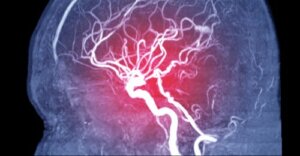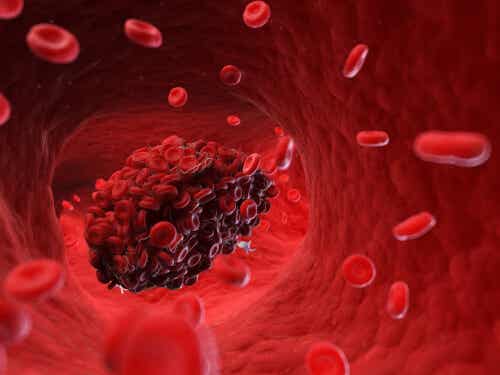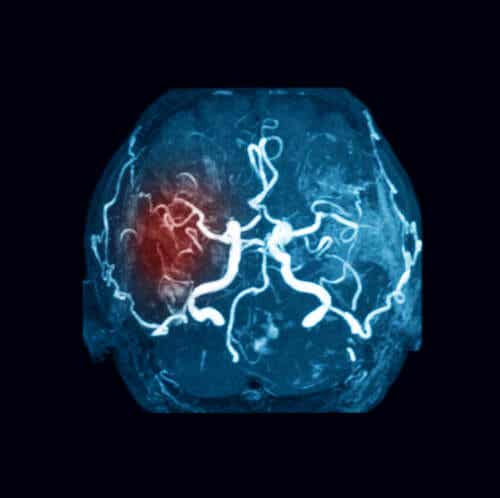Symptoms, Types, and Causes of a Cerebral Embolism


Written and verified by the doctor Leonardo Biolatto
The terms stroke and cerebral embolism often create confusion and are difficult to distinguish. A cerebral embolism is a type of infarction. It occurs when there’s an interruption in the blood flow to a given part of the brain.
Any tissue that blood cannot properly circulate to will be damaged due to a lack of oxygen. The brain is a particularly sensitive organ to this. Moreover, a person could lose certain functions, depending on the area affected.
Unfortunately, cerebrovascular diseases are the third leading cause of death in developed countries. In fact, they’re the leading cause of disability and dementia among adults.
This article will explain everything you need to know about strokes.
What’s a stroke?
An area of the brain is deprived of its blood supply during a cerebral embolism (stroke). This refers, specifically, to an obstruction of a blood vessel by an embolus.
An embolus is a mass transported to another part of the body with the blood — other than where it originated. It can be solid, liquid, or gas. However, it’s a blood clot more often than not.
Thus, a cerebral embolism, in general, consists of a blood clot originating in another part of the body. It travels with the blood until it reaches the vessels of the brain. There, it plugs the vessel blocking the blood flow to stop.
It’s important to be able to tell thrombi and emboli apart. Furthermore, a thrombus refers to a clot in the same vessel in which it arose, it doesn’t move. In turn, emboli don’t have a fixed position.

Types of embolism
As we mentioned above, there are different types of cerebral embolism. Also, cardiac emboli are blood clots are due to an alteration in the heart rhythm. The best example of these is atrial fibrillation.
It can also be due to an air embolus. This is an air bubble that keeps blood from circulating through the vessel. Fat emboli are accumulations of fat that detach from their original place and are typical of atherosclerosis.
Finally, note that cerebral embolism can also be due to a tumor process. In this case, part of the tumor or a group of cancer cells obstructs the vessel.
Find out more about Pulmonary Embolism: Symptoms and Treatment
The symptoms of cerebral embolism
The symptoms of a cerebral embolism can vary. They depend on the affected area of the brain. There are some common symptoms:
- Paralysis or numbness of some part of the body: in an arm and a leg, or half of the face
- A sudden headache
- Loss of vision
- Confusion and disorientation
- A sudden feeling of tiredness
The problem is that there may be serious complications if circulation isn’t restored as soon as possible. Sequelae are common after a cerebral embolism. For example, it may impair the language or the mobility of a limb.
Some people experience memory problems and have difficulty coordinating their movements. It’s, therefore, a medical emergency. As you can see, early treatment reduces the occurrence of complications.

Find out Everything You Need to Know About Pulmonary Thromboembolism
Treatment for cerebral embolism
It depends on the type of embolism and the affected area. The goal is to restore blood flow so, if it’s a clot, then drugs will be administered to destroy it.
Surgery is also necessary in some cases as well as a less invasive vascular treatment, with the help of a catheter. The attending nurse introduces it through another part of the body and moves it until it reaches the vessel where the embolus is.
Finally, know that a cerebral embolism is a medical emergency and it’s essential to see a doctor as soon as you notice any symptoms. They’ll prescribe treatment according to the individual characteristics of a patient.
All cited sources were thoroughly reviewed by our team to ensure their quality, reliability, currency, and validity. The bibliography of this article was considered reliable and of academic or scientific accuracy.
- Epidemiología de las enfermedades cerebrovasculares de origen extracraneal. (n.d.). Retrieved April 7, 2020, from http://scielo.sld.cu/scielo.php?script=sci_arttext&pid=S1682-00372014000200002
- ¿Qué es y cómo actúa una embolia? (n.d.). Retrieved April 7, 2020, from https://www.efesalud.com/embolia-que-es/
- Derrame cerebral- diagnóstico, evaluación y tratamiento. (n.d.). Retrieved April 7, 2020, from https://www.radiologyinfo.org/sp/info.cfm?pg=stroke
- Laguna, Victoria Romero, et al. “Embolia gaseosa cerebral.” Seram (2018).
- Ruibal León, Antonio J., Gilberto Durán Torres, and Verónica M. González García. “Tratamiento de la enfermedad cerebrovascular en su fase aguda.” Revista Cubana de Medicina 42.2 (2003): 124-127.
This text is provided for informational purposes only and does not replace consultation with a professional. If in doubt, consult your specialist.








